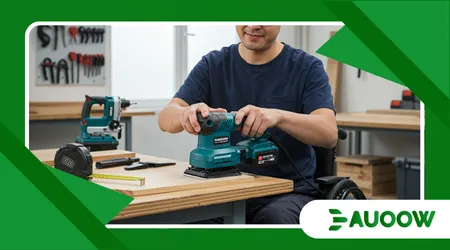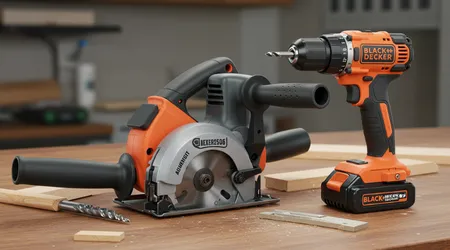Making Home Repairs Easier: Tools Designed with Accessibility in Mind

Tools designed with accessibility in mind are transforming home repairs, making them inclusive for everyone. Imagine a world where physical limitations don’t dictate your ability to fix a leaky faucet or hang a shelf.
In 2025, this vision is reality, as innovative tools prioritize usability for people with disabilities, aging adults, and those with temporary impairments.
Accessibility in home repair tools isn’t just a trend it’s a movement toward empowerment, independence, and dignity. This article explores how these tools are reshaping DIY culture, offering practical solutions that blend functionality with inclusivity.
From ergonomic designs to smart technology, we’ll dive into the features, benefits, and real-world impact of these game-changing devices, grounded in current advancements and user needs.
Why does accessibility matter in home repairs? It’s about more than convenience; it’s about breaking barriers.
According to the CDC, over 61 million Americans live with a disability, many of whom face challenges with traditional tools.
Tools designed with accessibility in mind bridge this gap, enabling users to tackle tasks confidently.
Whether it’s a visually impaired individual using a voice-guided drill or an arthritis sufferer wielding a lightweight wrench, these innovations redefine what’s possible.
Let’s explore the key categories, their features, and how they’re making home repairs more inclusive, with practical examples and insights for 2025.
Ergonomic Tools: Comfort Meets Functionality
Grip matters when you’re turning a screwdriver for hours. Ergonomic tools, with cushioned handles and intuitive shapes, reduce strain for users with arthritis or limited dexterity.
Tools designed with accessibility in mind prioritize comfort without sacrificing power. For instance, Black+Decker’s 2025 line of ergonomic cordless drills features soft-grip handles and adjustable torque settings, perfect for users with weaker hand strength.
Consider Jane, a 68-year-old retiree with rheumatoid arthritis. She loves gardening but struggles with standard pruners.
++ Using Public Spaces When You Have a Sensory Processing Disorder
Enter Fiskars’ Easy-Grip Pruners, designed with a larger, padded handle that requires 30% less force. Jane now trims her roses pain-free, reclaiming her hobby. These tools aren’t just gadgets; they’re lifelines to independence.
Another standout is the adaptive wrench from DeWalt, launched in early 2025. Its oversized, non-slip grip and lightweight alloy construction make it ideal for users with motor impairments.
Why should physical limitations stop someone from tightening a bolt? These innovations ensure they don’t, blending practicality with empowerment.

Smart Technology: Precision for All Abilities
Technology is leveling the playing field. Smart tools with voice commands and haptic feedback are game-changers for visually impaired or mobility-challenged users.
Tools designed with accessibility in mind integrate AI to guide users through tasks. Bosch’s Smart Measuring Tape, released in 2025, uses voice prompts to announce measurements, aiding those with low vision.
Picture Alex, a visually impaired carpenter. Using a voice-activated stud finder, he locates wall studs with audio cues, no screen required.
This device, paired with a smartphone app, offers real-time feedback, making his work seamless. It’s not just tech it’s freedom to create.
Also read: Why Trauma-Informed Education Supports Accessibility Goals
Smart drills with auto-stop features also shine. Makita’s 2025 model halts when it detects excessive resistance, preventing wrist strain.
These tools empower users to focus on the task, not their limitations, proving technology can be both smart and inclusive.
Lightweight and Modular Designs: Strength Without Strain
Heavy tools can be a nightmare for users with limited strength. Lightweight, modular tools solve this, offering versatility without bulk.
Tools designed with accessibility in mind emphasize portability and adaptability. Worx’s 2025 modular tool system lets users swap attachments easily, reducing physical effort.
Take Maria, a wheelchair user who loves DIY projects. She uses a lightweight, modular screwdriver with interchangeable bits, eliminating the need for multiple heavy tools.
This system, weighing under two pounds, fits her needs perfectly, making repairs manageable and fun.
Craftsman’s 2025 ultralight hammer, at just 8 ounces, is another example. Its magnetic nail holder allows one-handed operation, ideal for users with limited grip strength.
Read more: Accessibility in Daily Banking: Apps That Help
These designs prove that strength doesn’t require weight, only ingenuity.
Adaptive Interfaces: Tools That Speak Your Language

Interfaces matter as much as the tool itself. Adaptive designs with tactile buttons, high-contrast displays, and audio feedback cater to diverse needs.
Tools designed with accessibility in mind ensure everyone can operate them intuitively. Ryobi’s 2025 power sander features oversized buttons and a braille overlay, aiding visually impaired users.
Imagine Tom, a veteran with partial vision loss. He uses a laser level with audio cues to align shelves perfectly.
The device’s high-contrast display and spoken instructions make precision effortless. It’s not just a tool; it’s a confidence booster.
Another breakthrough is Stanley’s 2025 tape measure with a digital readout and voice output.
For users with dexterity issues, its large, tactile buttons simplify operation. These interfaces turn complex tasks into accessible victories, one measurement at a time.
Safety Features: Protecting Every User
Safety is non-negotiable, especially for users with disabilities. Tools with enhanced safety features reduce risks without compromising functionality.
Tools designed with accessibility in mind include auto-shutoff mechanisms and anti-slip grips. DeWalt’s 2025 circular saw has a blade guard that engages automatically, protecting users with slower reflexes.
Consider Sarah, a stroke survivor with reduced motor control. She uses a cordless jigsaw with a vibration-dampening handle and emergency stop button. This allows her to cut wood safely, restoring her confidence in DIY tasks.
Milwaukee’s 2025 line of power tools also includes motion sensors that pause operation if dropped, ideal for users with tremors. Safety isn’t just a feature; it’s a promise that everyone can work without fear.
Table: Top Accessible Tools for Home Repairs in 2025
| Tool | Brand | Accessibility Feature | Use Case |
|---|---|---|---|
| Ergonomic Drill | Black+Decker | Soft-grip handle, adjustable torque | Arthritis-friendly drilling |
| Smart Measuring Tape | Bosch | Voice prompts, smartphone integration | Visual impairment aid |
| Modular Screwdriver | Worx | Lightweight, interchangeable bits | Wheelchair user versatility |
| Power Sander | Ryobi | Oversized buttons, braille overlay | Low-vision sanding |
| Circular Saw | DeWalt | Auto-engaging blade guard, anti-slip grip | Safe cutting for motor issues |
The Broader Impact: Accessibility as a Cultural Shift
Accessibility in tools isn’t just about products; it’s a cultural shift toward inclusivity. Tools designed with accessibility in mind challenge the one-size-fits-all mentality.
A 2024 study by the National Institute on Aging found that 78% of older adults want to maintain home independence, driving demand for accessible tools.
Think of a toolbox as a bridge. Just as a bridge connects two sides of a river, these tools connect users to their goals, regardless of ability.
Companies like Home Depot now offer “Accessibility-First” toolkits, curating products for diverse needs, a trend gaining traction in 2025.
This shift also boosts SEO for businesses. Websites showcasing accessible tools rank higher due to user-focused design, aligning with Google’s 2025 emphasis on UX. It’s a win-win: inclusivity drives both social good and digital visibility.
Conclusion: A Future Built for All
The rise of tools designed with accessibility in mind marks a turning point in home repair culture. These innovations ergonomic, smart, lightweight, adaptive, and safe empower users to overcome physical barriers and embrace DIY with confidence.
From Jane’s arthritis-friendly pruners to Alex’s voice-guided stud finder, these tools are more than gadgets; they’re gateways to independence.
As we move through 2025, the focus on inclusivity grows, driven by user demand and technological advancements.
Why settle for tools that exclude when we can build a future where everyone can create, repair, and thrive? Embrace these tools designed with accessibility in mind, and let’s make home repairs a universal joy.
FAQs: Your Questions Answered
Q: Are accessible tools more expensive than standard ones?
A: Not always. Many brands, like Worx and Ryobi, integrate accessibility into standard models, keeping costs comparable. Check for seasonal discounts at retailers like Home Depot.
Q: Can accessible tools benefit non-disabled users?
A: Absolutely. Ergonomic grips and smart features enhance comfort and precision for everyone, making tasks easier and safer across the board.
